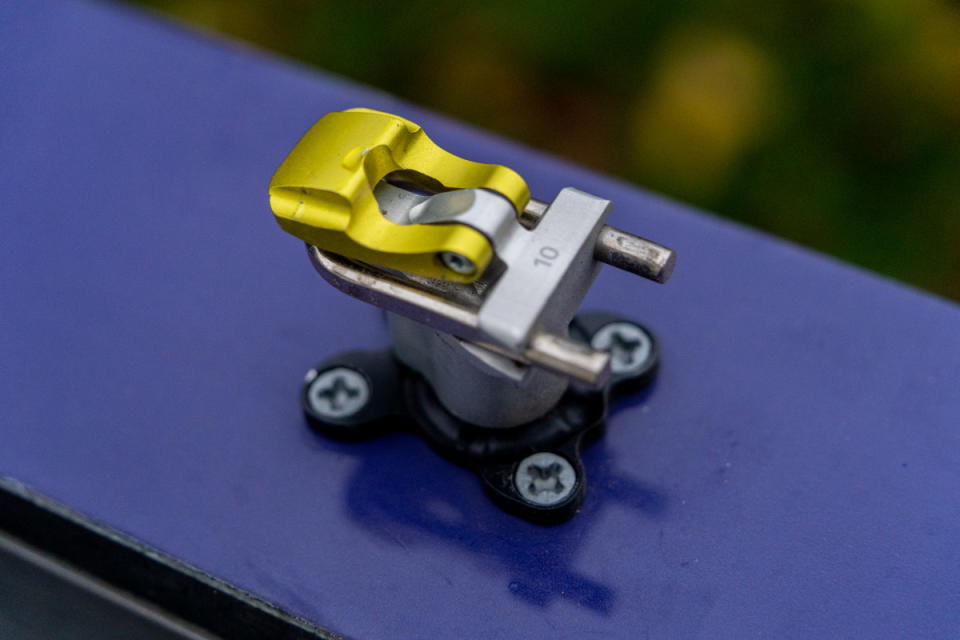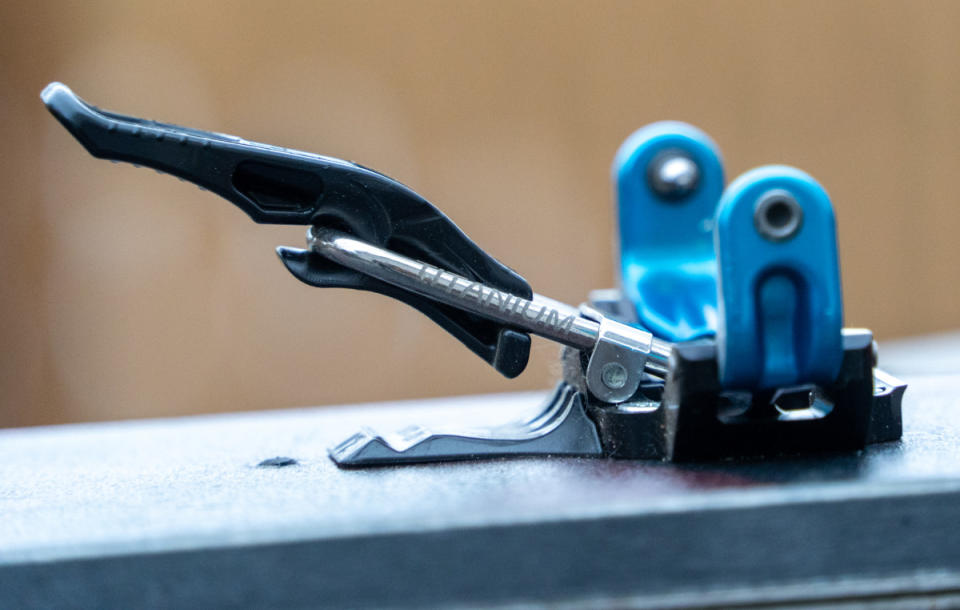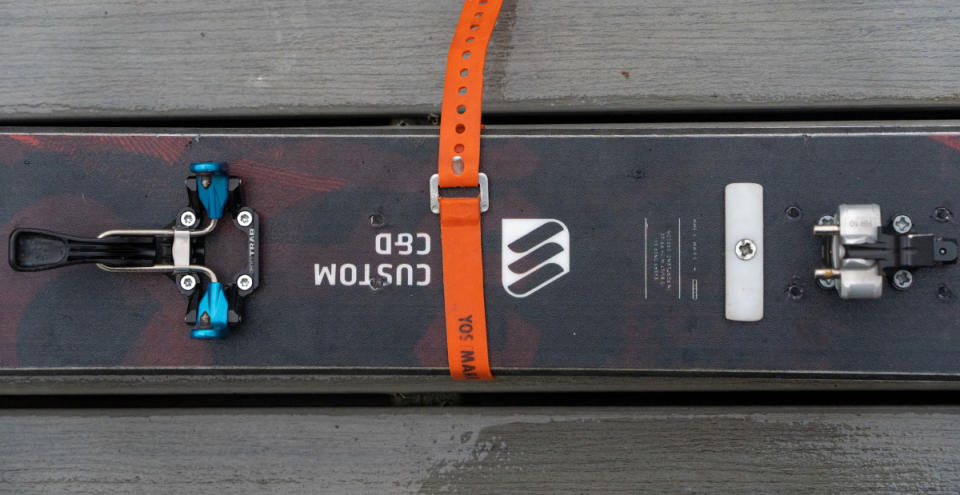So you want to mess around with lighter bindings
Powder aims to feature only the best products and services. If you buy something via one of our links, we may earn a commission.
Some background: I’ve long been a proponent of saving weight in your boots and bindings, before getting lighter skis. I’d rather tour on ultralight bindings with my inbounds skis than ski burly bindings on a super light ski. So, yes, feel free to buy lighter skis and boots, but this binding conversation is going to assume that you have an appropriate ski (1300-2000 g per ski) and an appropriate boot (sub 1600 g with a good walk mode).
Your First Tech Bindings
This is not a touring binding 101 piece. This is for folks who know they should be skiing a full pin setup in the backcountry, and are trying to figure out which one they’re interested in. Hybrid bindings like Cast and Shift are great for skiing inbounds, great for people that get paid to ski, and great for people who walk uphill occasionally. But for lots of folks, the difference between touring occasionally and touring a lot is a lighter, more efficient setup. I am assuming that readers of this piece are already at that point, ready for a full tech binding and all the weight and efficiency upgrades it comes with. We are not going to talk about hybrid bindings, or frames, or adaptors in this piece.
If you've already drunk the koolaid, and are running race bindings on your everyday skis, congrats! You're ahead of the curve, and this piece might not be as useful to you.
And, if you don’t have any pro deals, don’t want to read a lot of other words, and just want your first tech bindings, you should buy the Moment Voyager in the appropriate release value range for you. Just do it. It’s that good. It makes things very simple. I am not paid by Moment. I get better deals on other bindings. It doesn’t matter. The Voyager, in the parlance of the kids, fucks.
But, reading reviews is fun. So read about other bindings–maybe they make more sense for you. And maybe, just maybe, something lighter, like the bindings we’ll cover here, is in your future. So let’s dive into the factors that combine to create the performance profile of a tech binding.
Weight
This one is obvious. It is what it is, but stop thinking about weight as a single number. Instead, see it as the sum total of the weight of modular parts. You can buy toes, heels, and freeride spacers separately, and mix and match to your heart’s content. No, you won’t be covered by warranty or in the case of an injury, but you probably weren’t really covered in the first place anyway. (By the way, don’t read this, make poor choices, blow up your knees, and get mad at me. Skiing is dangerous. Be the arbiter of your own choices and the master of your own destiny.)
Release Value
Release value is not DIN, because it’s not certified like DIN is. Instead, it’s an approximation that sort of lines up to what DIN you run. Don’t equate the two, but your standard DIN is a good place to start with your RV.
On some tech bindings you can adjust the rotational heel RV, but not the vertical. It also matters how that RV is accomplished; u-spring bindings are more prone to wear, and less adjustable, than those with some other mechanism.
I prefer cammed heel pins instead of a u-spring, just because they’re a lot easier to get into, and they’re theoretically more consistent and safer, but this is honestly the feature I would capitulate on the easiest.

BSL Adjustment
Do you want to ski these bindings with boots with different BSLs, or are you married to one pair? I am lucky in that all the boots I want to tour in have the same BSL, so I can get away with fixed heels, for even cleaner aesthetics and weight savings. But, BSL adjustments also can end up affecting…
…Ramp Angle
Told you this was going to be some nerd shit. Ramp angle, or delta, is the difference in the height of your toe pins and your heel pins. There isn’t one perfect ramp angle for everyone, but you’ll probably prefer a certain range. Me, I like a pretty flat ramp, 5 mm or less. It’s easy to adjust ramp to a certain extent. You can shim toes or heels, or use a BSL adjust plate to accomplish the same thing, while also gaining adjustment and weight.
I’ve never noticed a binding being too flat, but I can tell when a binding is too ramped in just a few laps. I find that the front of my thighs gets really tight and fatigued quickly, and I struggle to keep my tips up. So I either shim my toes or shop for lower heels.
Heel Riser Options
Once you start flirting with the really light options, you’ll find that some bindings lack flat modes, and lots lack high risers. How big of a deal is that to you? If you’re always totally happy with the single Shift riser, you’ll probably be ok. If you have boots with a great walk mode, you’ll also probably be ok. I’ve got crappy ankles and I spend too much time in a place where dudes prove their manhood by setting skin tracks straight up stuff. I need at least a moderately high option.
Heel Spring Compensation
Ok, this one is sorta complicated. But, when your ski flexes, especially when you load your tails, it pushes the toe and heel of your binding together. If the heel is on a spring loaded track, it can move back, and keep your boot locked in better. If it’s not, you might come out of your bindings or blow up the heel piece. Some bindings from Plum now have this in the toe, but it’s doing the same thing.
Spring compensation is cool, but it adds weight, and heel height. Some bindings with spring compensation are “gapless”; in other words, the heel kisses the heel of your boot, instead of just the pins touching. On most tech heels though, there’s a gap, so that the ski can flex without causing the heel of your boot to impact the heel of your binding. Some folks argue that gapless bindings ski better, more like an alpine binding. In my experience, the presence or absence of a freeride spacer makes a much bigger difference.
I would love to see a somewhat universal (most ultralight heels share the same hole pattern) BSL adjust plate that also includes spring compensation so that you can mix and match this feature too.
Brakes
You need them less than you think you do. I know, I used to think I really needed brakes. And then I remembered that I’ve had plenty of skis take off downhill on pow days, even with brakes. And then I skied for a month or two with my brakes locked up, realized I didn’t need them, and took them off. If you still crash a lot, you might want brakes. Or maybe that means you shouldn’t be on tech bindings yet. But for most intermediate to advanced skiers, you probably need them less than you want them as a placebo.. You might need leashes depending on the situation. But you probably need those less than you think too (gasp!).

Vertical Support
AKA, a Freeride Spacer (thanks ATK for the name). Smart folks have figured out that if you’re just floating on your pins, it can feel like just that: a vague float. But, if there’s something under your heel to push into, a lightweight binding can feel much burlier than it used to. In my experience, a freeride spacer of some sort can make an ultralight binding ski 85% as well as a Kingpin. Some ATK bindings have a built-in spacer. ATK also sells a separate spacer that you can mount to the ski on its own.
The ATK stand-alone one is great, but is a little fragile, and is pretty tall - it won’t fit under the lower stack bindings I’m running.
So I’ve made my own out of a polyethylene cutting board. I made sure that the height is similar to how you’d set up a regular AFD. I can slide a piece of paper between the spacer and my boot sole on the bench. They are probably making the release value of my bindings less consistent, but these are light tech bindings, so there are no safety guarantees anyway, and these make them ski well enough that I’ll take it.
So What?
It's up to you to figure out which of those features you require. I’m looking for the lightest, most efficient, and most reliable uphill binding that still allows me to ski somewhat aggressively on the way down, so I think my priorities might align well with lots of folks out there. Thus the Voyager recommendation.
Why Voyagers instead of the original ATKs that Moment is rebranding? The Moment version has a flatter ramp angle (higher toe pins) than the normal ATK version. ATK makes a version with the flatter ramp now, but it can be confusing to figure out which of the approximately ten thousand ATK binding options it is. So, when in doubt, Voyager it out.
But, I’m a nerd, so I’ve been messing around with lighter bindings. Here are my priorities, mostly in order:
Weight: sub-200 g (Voyagers are 400ish g, so I wanted to cut that in half)
RV: I need at least a 10. I’m heavy and flaily
Ramp Angle: I like flat. Like, real flat, less than 5 mm of delta.
Vertical Support: It makes a big difference, and only costs about 10 grams
High-ish high risers: bad ankles. I can’t get away with a race flap that just covers the pins
No, I don’t need brakes, I’m experimenting with not having heel spring compensation (so far so good), and I ski the same pair of boots for everything so I don’t need BSL adjustment.
Resources
Skimoco is a nerd’s best friend. Their pin height chart allows you to mix and match deltas, they list actual weights, they list riser heights, they list hole patterns, and they sell toes and heels independently. No. They are not paying me. I just use their site a lot, and then buy lots of things from them.
The TGR Sub 300 g binding thread also has lots of info that’s helped me along my way. It is important to use that info to inform your own priorities, instead of obsessing over what other folks want out of a binding.
Where I’ve Landed
After a lot of nerding out on the internet, here’s what I’ve found: Ski Trab makes the coolest toes on the market. They’re light and non-traditional. You do have to hold them open to get into them, but that’s fine in practice. They ski better than they should. They have a certain elastic feeling. Instead of feeling like your boot bolted straight to the ski, like a traditional tech binding, they feel like they can absorb impacts more like an alpine binding. And they stay on better than ATK toes in my experience. The pins move with each other to compensate, instead of popping open immediately when you try to do some dumb new school stunt. And Trab offers a 5 mm shim so you can mess with ramp angles.

But Trab’s heels don’t work for what I’m trying to do. The Titan Vario 2 heel is gapless, so hypothetically it skis better, and it has a high enough riser option. But it’s really tall–you end up with an 8.5 mm delta, with the 5 mm shim installed. It’s also sorta heavy. I skied a day on the full Titan Vario 2 binding and I noticed the delta immediately. I felt like I was on high heels. Maybe you won’t notice it, maybe you’ll like it. I did not. So I tried to shim the toes, but man, 11 total mm of shims under a toe is weird and sorta sketchy. Instead I sold the Vario heels (but not the sweet toes) and moved on. Yes, I could have used Trab race heels, but the u-spring and lack of a higher riser kept me away.
The other binding that caught my eye initially was the ATK Haute Route. It has cam style heel pins, no u-spring, adjustable vertical and horizontal release, and a nice low pin height. So I bought just the heels from Skimoco. Boom! Big fan. This heel, combined with Trab toes and a homemade Freeride Spacer, weighs 180 g, is pretty flat, and skis really, really well. Last season I made some dumb decisions, trying some backcountry nosebutters, and jumping off big rocks into flat landings with this combo, and it was awesome. The only thing this heel is lacking is elastic compensation. As far as I can find, it’s impossible to get that without getting a much taller heel and gaining a bunch of weight. Enough weight in fact, that you might as well just get a Voyager. So elastic heel compensation is my sacrificial lamb in this experiment. Sure, the high riser could be higher, but it’s fine for what I do.

You can hypothetically run a Dynafit Superlight 2.0 heel to accomplish the same thing, and some folks argue that it has a better return to center than the Haute Route, so it’s less likely to pre-release. But it’s a u-spring binding with more plastic and a weird hole pattern that requires weird adjustment plates. So I stuck to the brand I know better, ATK, and now have more modularity between skis since all my heels have the same hole pattern, and Trab toes have the same hole pattern as the lighter weight ATK toes.
I’m running this combo on two skis: on a Moment Deathwish Tour, with the heel BSL adjust plate, and the 5 mm toe shim; and on an ON3P Jeffrey 118 Tour with no plate or shim. Both lead to a basically (within 2 mm) flat setup.
I initially tried a Trofeo with a modded high riser and a freeride spacer. That combo was fine, and a hair lighter, but the high riser was sketchy, and I much prefer the independent pins of the Haute Route heel to the u-spring of the Trofeo. They’re adjustable, easier to get into, and are hypothetically safer. So the Trofeos are going on my blades.
A Note on My Cruciate Ligaments
I wrote most of this piece last spring. And then I hit a big log drop to a flat landing, in kinda manky snow, while skiing my 180 g frankenbindings on 118 mm underfoot skis. And I tweaked my knee. I tweaked it hard enough that I initially thought I’d torn something important. I hobbled out, iced it, saw a doctor, saw a PT, and concluded that I hadn’t done anything too terrible to it. I was back on skis ten days later, although I wasn’t skiing at 100% until June.
Believe me, I have gamed out that hit, that impact, that injury a thousand times. It’s my first real knee injury skiing, and I’m so mad it happened. But no matter how many times I play that scenario back, I can’t blame the bindings. I didn’t release, but I don’t think I would have released from any binding, especially not any tech binding. There were a bunch of heuristics at play, and I made a bad call that left me hurting. I landed and put my shutdown turn hard into the slope. I think my boot caught a branch under the snow and brought my left leg to a hard stop, so that all of my weight collapsed onto it. Because my boot caught, and not my binding or ski, I don’t think a more releasable or “safer” binding would have changed the outcome.
Conclusion
Running your stock bindings is totally fine. They’ll ski well and walk fine and you’ll have a grand old time. But if you’re a nerd, mixing and matching toes and heels is a blast, and can leave you with a setup that skis and walks well, and is much lighter than the alternatives. Figure out your priorities, figure out what elements of which bindings match those priorities, and then get weird!

